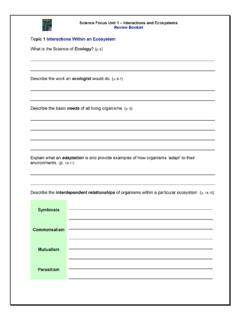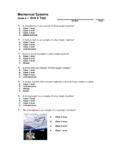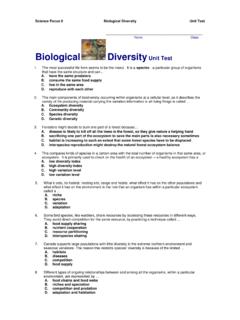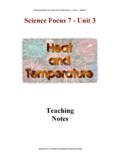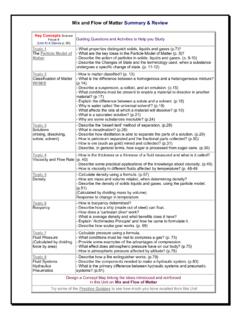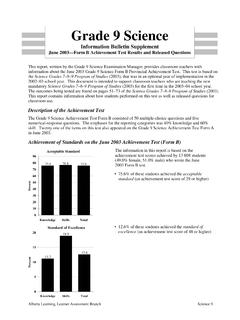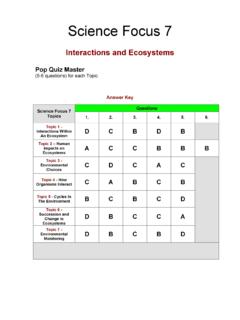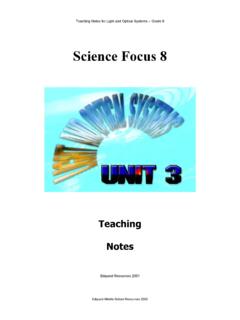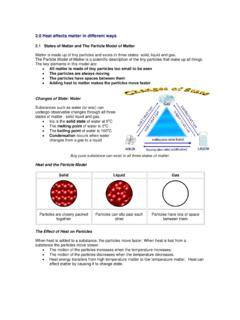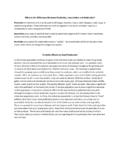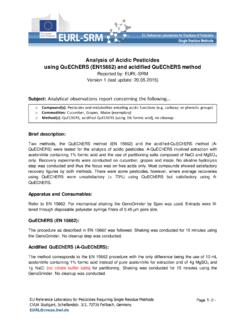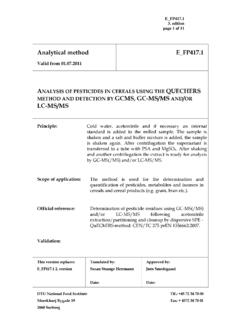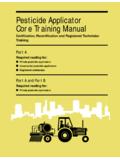Transcription of Unit 2 – Plants For Food And Fibre
1 REVIEW .. Key Concepts unit 2 Plants For food And Fibre Structures and Life Processes Seed Plants have roots, stems, leaves and either flowers or cones Each structure performs a specific function Life processes in Plants include: Photosynthesis, Transpiration Gas exchange (cellular respiration) Seed plant life cycle includes three stages: Seed stage, Seedling stage, and Adult stage Pollination is the joining of pollen and ovary Seed Plants can also reproduce in ways not involving seeds: Runners, rhizomes, suckers, cuttings and grafting Adaptations help Plants get what they need from the environment Growing conditions varies between and among Plants , and can be modified using technology Role of Plants to Meet Human Needs Plants supply oxygen and food Plants are used for food , Fibre (to make things)
2 , medicine, and other products Natural resources vs Managed resources Soil Minerals and organic matter in different amounts make clay, sandy soil or loam Growing and harvesting methods can improve or degrade soil Growing and Using Plants Sustainability Selective breeding provides specific desirable traits New varieties may lead to environmental problems Resistance, loss of species or pollution can occur with long term use of herbicides and pesticides Sustainability balancing out needs with the needs of the environment and the consequences (social and economic)
3 Structures and Life Processes Seed Plants have roots, stems, leaves and either flowers or cones Identify the structures of a seed plant from the illustration below Each structure performs a specific function Explain the function of the following seed plant structures Structure Function Roots _____Stems _____Leaves _____Flowers _____Seeds _____Cones _____ Why do Plants produce seeds? _____ _____ Life processes in Plants Explain the following life processes of a seed plant.
4 Moving water from the roots to the other parts of the plant Transpiration _____ _____ _____ Capillary Action _____ _____ _____ Moving substances in and out of plant cells Diffusion _____ _____ _____ Osmosis _____ _____ _____ Active Transport _____ _____ _____ Making food Photosynthesis _____ _____ _____ Using food Gas exchange (cellular respiration) _____ _____ _____ Illustrate a word equation for this process (cellular respiration) Seed plant life cycle includes three stages: Illustrate the life cycle of a typical seed plant, such as a dandelion.
5 Pollination is the joining of pollen and ovary Explain the process of pollination _____ _____ _____ What organisms are considered to be pollinators? _____ What else can be a pollinator? _____ Seed Plants can also reproduce in ways not involving seeds: Describe how each of the following types of vegetative reproduction can produce new Plants Runners _____ _____ _____ Rhizomes _____ _____ _____ Suckers _____ _____ _____ Cuttings _____ _____ _____ Grafting _____ _____ _____ Adaptations help Plants get what they need from the environment Illustrate with examples Plants that have adapted to the environments described below.
6 (Explain how the adaptation helps the plant to survive in the environment in which it grows.) Desert Environment Mountain Region Open Flat Prairie Environment Lake Growing conditions vary between and among Plants , and can be modified using technology What are the best growing conditions for Plants ? _____ _____ _____ _____ Role of Plants to Meet Human Needs Plants play an essential role in the environment What specific roles do Plants have in our environment? _____ _____ _____ _____ _____ _____ Plants are used for food , Fibre (to make things), medicine, and other products Give examples of how Plants are used for the following purposes.
7 food Fibre Medicine Other Products Natural resources vs Managed resources Explain what living resources are. _____ _____ What human activities caused changes in the supply of living resources. _____ _____ Who is responsible for managing the living resources we have in Alberta?
8 Canada? Alberta _____ Canada _____ Soil Minerals and organic matter in different amounts make clay, sandy soil or loam What is the difference between organic particles and mineral particles in soil? _____ Briefly describe the characteristics of each type of soil. Sandy Soil Clay Soil Loam Soil Growing and harvesting methods can improve or degrade soil Soil is an important resource in our environment. How are nutrients replaced in the soil when they are used up? _____ _____ What are some practices that can improve, or cause harm to soil quality?
9 Improving soil quality Degrading soil quality Growing and Using Plants Sustainability Describe three different ways to modify an environment _____ _____ _____ What technologies have been developed to improve yields? _____ _____ _____ _____ Selective breeding provides specific desirable traits Match each of the following terms: 1. Species _____ A subset of a species 2. Variety _____ Specific characteristics that distinguish it from other organisms 3. Trait _____ A group of organisms with similar traits What is selective breeding?
10 _____ _____ What is genetic engineering? _____ _____ Explain what a hybrid is. _____ _____ What happens when parents with different traits reproduce? New varieties may lead to environmental problems Describe an unintended consequence when a new variety of plant is produced. _____ _____ Resistance, loss of species or pollution can occur with long term use of herbicides and pesticides What are the different kinds of pests that can affect Plants ? _____ _____ _____ _____ Explain why each of the following are used and what unintended consequence has occurred as a result of its use.
